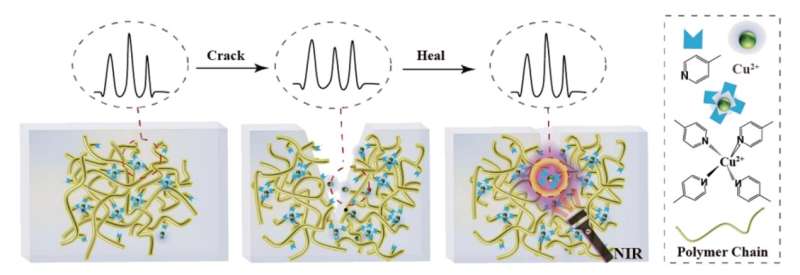A fast-healing and high-performance metallosupramolecular elastomer based on pyridine–Cu coordination

This study is led by Dr. Jinrong Wu (State Key Laboratory of Polymer Materials Engineering, College of Polymer Science and Engineering, Sichuan University). In high-speed devices, cracks propagate very quickly and brings irreversible destruction. However, materials that can self-heal quickly often have poor performance. In many applications, once a crack appears, a catastrophic accident may occur if it is not repaired in time. Therefore, it is extremely important to develop fast self-healing materials without compromising their mechanical properties.
A NIR light self-healing metallosupramolecular elastomer with high mechanical properties was prepared by simply introducing pyridine-Cu coordination into a copolymer, in which the pyridine-Cu complex could absorb NIR light and convert it into heat. This intense photothermal effect endows the elastomer with the ability to heal scratches under NIR light for 2 min.
In addition, the team investigated the molecular dynamics that drives the rearrangement of the network and self-healing of the elastomer, and find that the dissociation and reconstruction of the coordination bonds can be reflected by the Raman spectrum change. Therefore, the bond-level self-healing process can be tracked by laser confocal micro-Raman spectroscopy.
This work represents a qualitative change in the development of fast-healing and high-performance metallosupramolecular elastomer. Moreover, this work also provides a method for real-time monitoring of bond-level healing kinetics.
The research was published in Science China Materials.
More information: Hui Liu et al, A fast-healing and high-performance metallosupramolecular elastomer based on pyridine-Cu coordination, Science China Materials (2022). DOI: 10.1007/s40843-021-1963-2
Provided by Science China Press



















